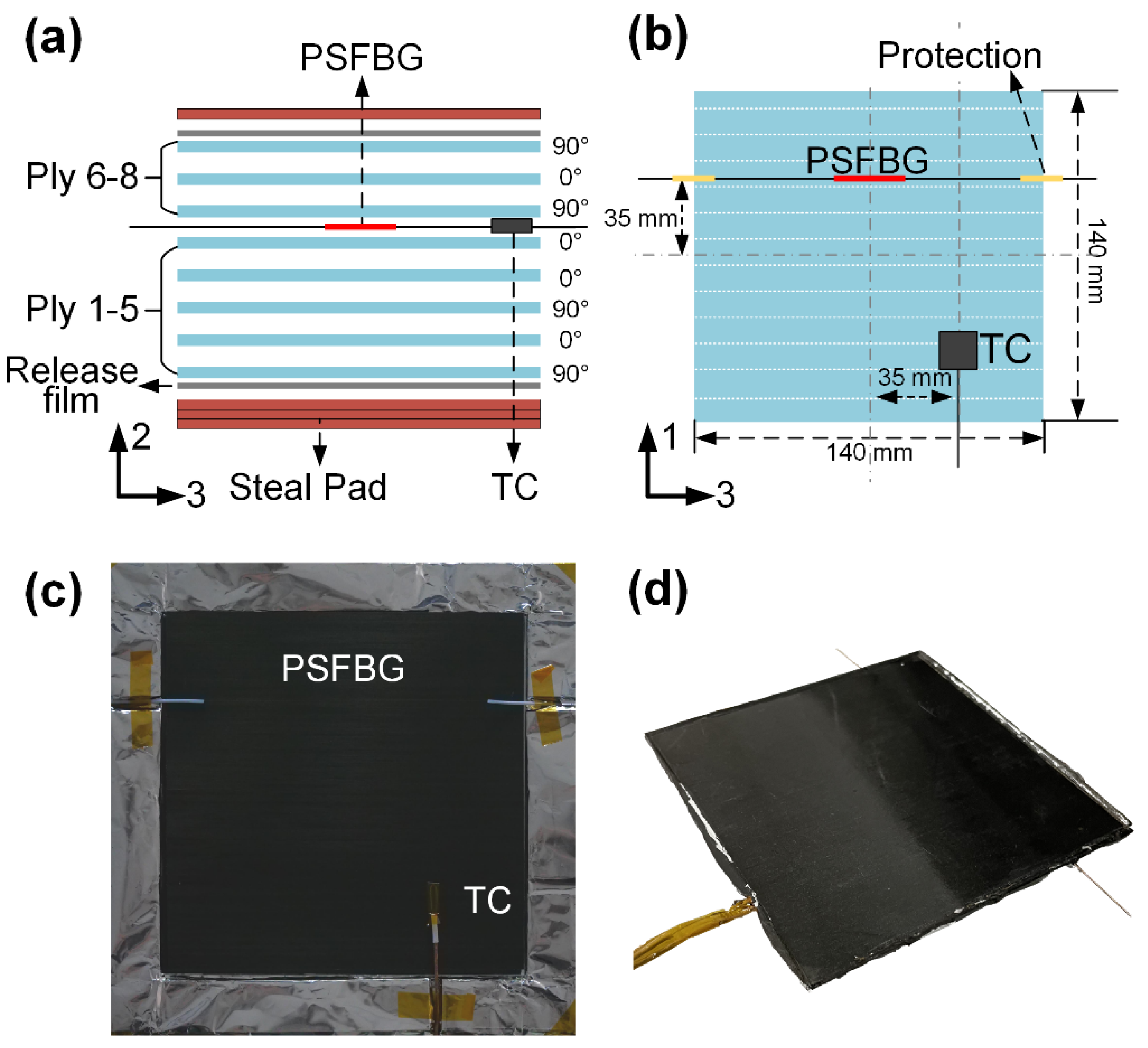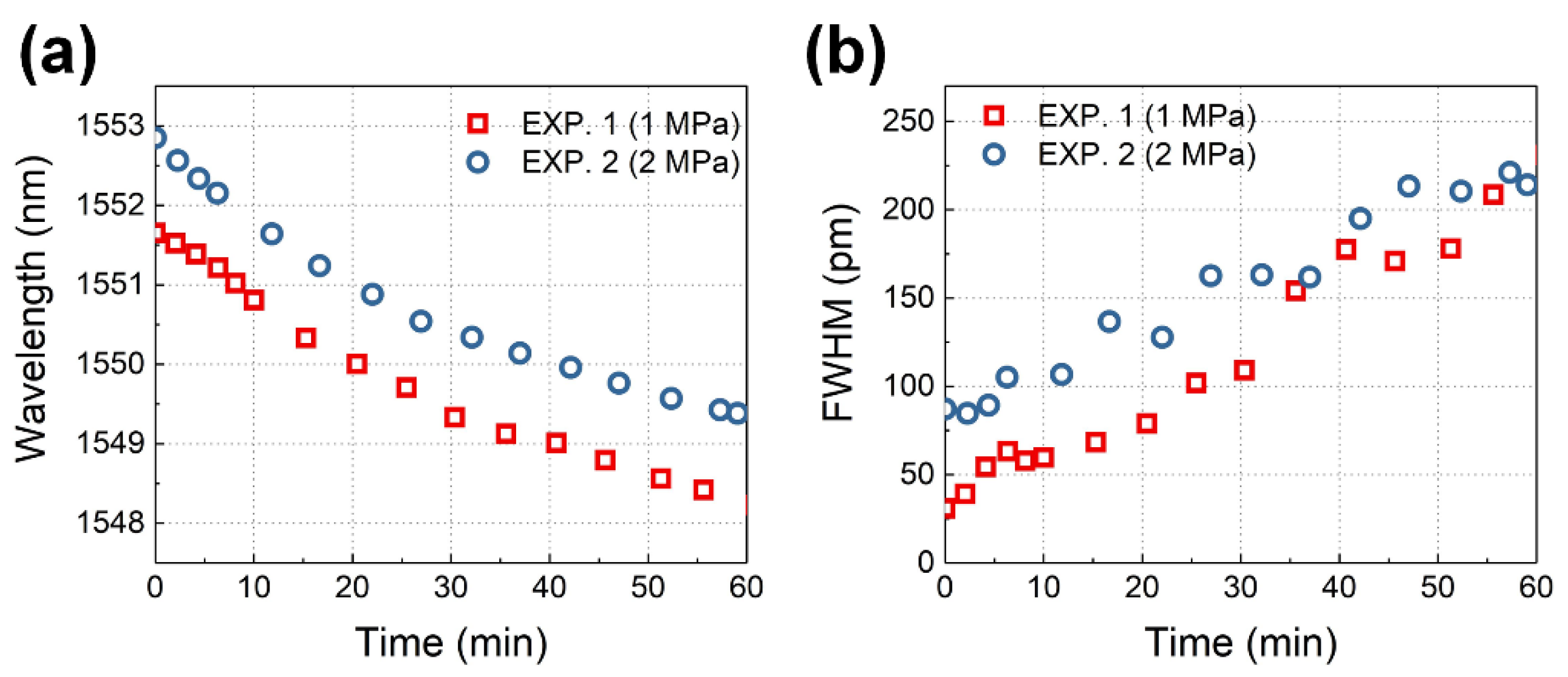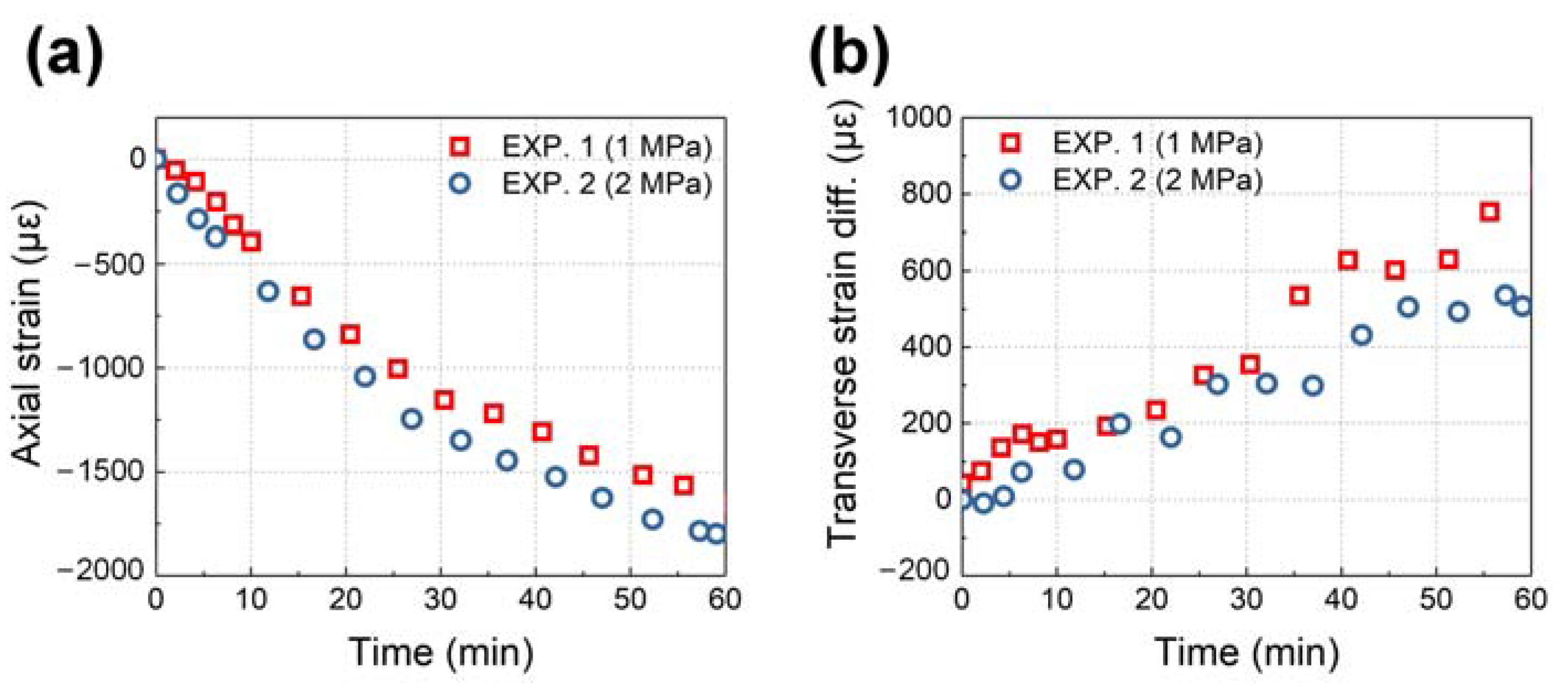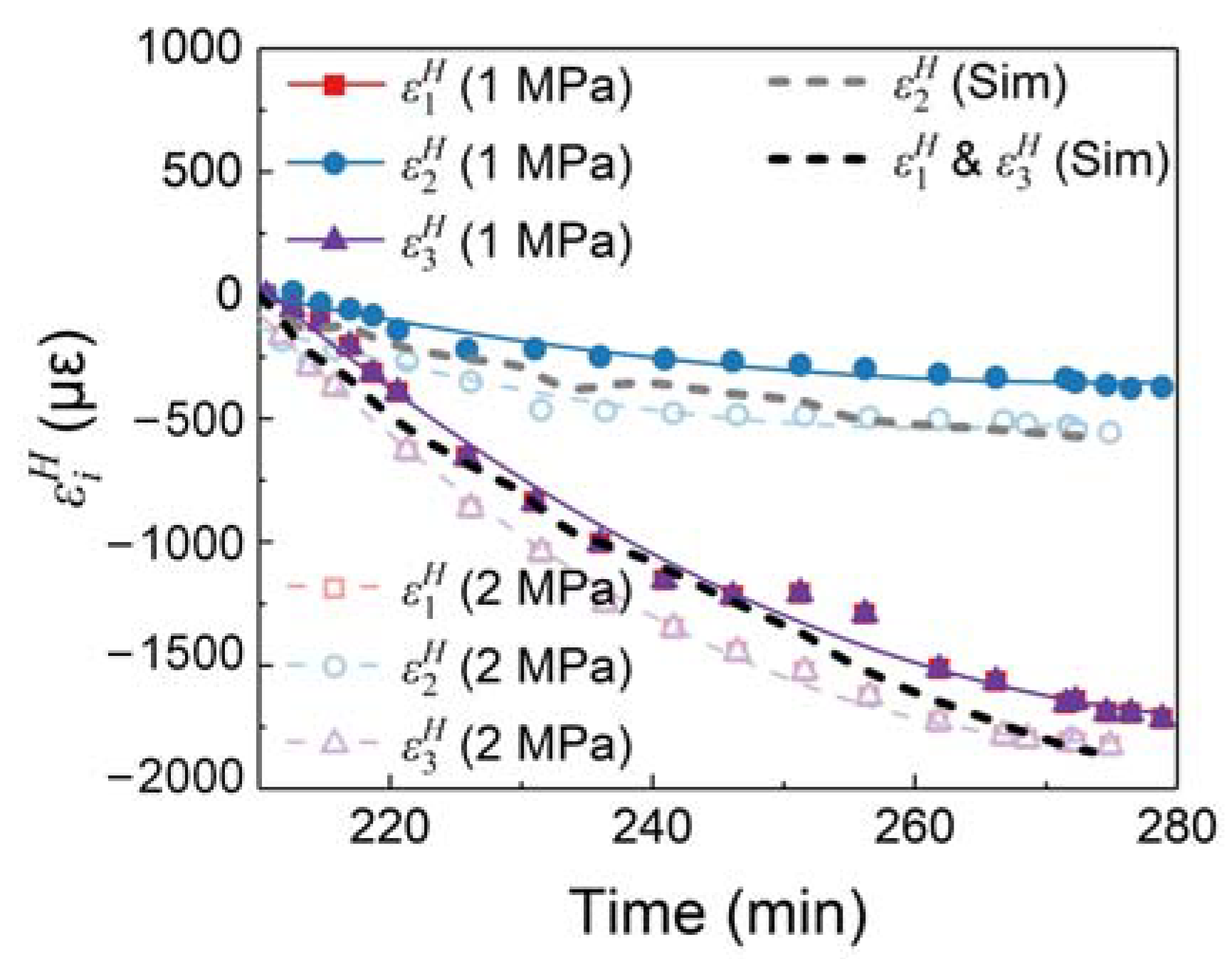Multi-Directional Strain Measurement in Fiber-Reinforced Plastic Based on Birefringence of Embedded Fiber Bragg Grating
Abstract
1. Introduction
2. Mechanism
2.1. Sensing Principle
2.2. Strain Transfer Relationship
2.3. Decoupling Methodology
3. Simulation
3.1. Finite Element Model
3.2. Boundary Condition
4. Experiment
4.1. Sensors
4.2. Experiment System
5. Results and Discussion
5.1. Simulation Results
5.2. Strains Derived from Spectral Response
5.3. Tri-Directional Strains
6. Conclusions
Author Contributions
Funding
Data Availability Statement
Conflicts of Interest
References
- Othman, R.; Hisyam Basri, M.; Ismail, I.; Ab, M.A.; Pahmi, H.; Hisyam, M.; Basri, M.; Sharudin, H.; Rahman Hemdi, A. Application of Carbon Fiber Reinforced Plastics in Automotive Industry: A Review. J. Mech. Manuf. 2019, 1, 144–154. [Google Scholar]
- Zhai, H.; Wu, Q.; Bai, T.; Yoshikawa, N.; Xiong, K.; Chen, C. Multi-Scale Finite Element Simulation of the Thermoforming of a Woven Fabric Glass Fiber/Polyetherimide Thermoplastic Composite. J. Compos. Mater. 2023, 57, 1–22. [Google Scholar] [CrossRef]
- Grattan, K.T.V.; Sun, T. Fiber Optic Sensor Technology: An Overview. Sens. Actuators A Phys. 2000, 82, 40–61. [Google Scholar] [CrossRef]
- Mulle, M.; Wafai, H.; Yudhanto, A.; Lubineau, G.; Yaldiz, R.; Schijve, W.; Verghese, N. Process Monitoring of Glass Reinforced Polypropylene Laminates Using Fiber Bragg Gratings. Compos. Sci. Technol. 2016, 123, 143–150. [Google Scholar] [CrossRef]
- Moretti, L.; Olivier, P.; Castanié, B.; Bernhart, G. Experimental Study and In-Situ FBG Monitoring of Process-Induced Strains during Autoclave Co-Curing, Co-Bonding and Secondary Bonding of Composite Laminates. Compos. Part A Appl. Sci. Manuf. 2021, 142, 106224. [Google Scholar] [CrossRef]
- Mulle, M.; Collombet, F.; Olivier, P.; Zitoune, R.; Huchette, C.; Laurin, F.; Grunevald, Y.H. Assessment of Cure-Residual Strains through the Thickness of Carbon-Epoxy Laminates Using FBGs Part II: Technological Specimen. Compos. Part A Appl. Sci. Manuf. 2009, 40, 1534–1544. [Google Scholar] [CrossRef]
- Minakuchi, S.; Umehara, T.; Takagaki, K.; Ito, Y.; Takeda, N. Life Cycle Monitoring and Advanced Quality Assurance of L-Shaped Composite Corner Part Using Embedded Fiber-Optic Sensor. Compos. Part A Appl. Sci. Manuf. 2013, 48, 153–161. [Google Scholar] [CrossRef]
- Chen, C.; Wu, Q.; Xiong, K.; Zhai, H.; Yoshikawa, N.; Wang, R. Hybrid Temperature and Stress Monitoring of Woven Fabric Thermoplastic Composite Using Fiber Bragg Grating Based Sensing Technique. Sensors 2020, 20, 3081. [Google Scholar] [CrossRef]
- Geng, X.; Jiang, M.; Gao, L.; Wang, Q.; Jia, Y.; Sui, Q.; Jia, L.; Li, D. Sensing Characteristics of FBG Sensor Embedded in CFRP Laminate. Meas. J. Int. Meas. Confed. 2017, 98, 199–204. [Google Scholar] [CrossRef]
- Zhi, J.; Yang, B.; Li, Y.; Tay, T.E.; Tan, V.B.C. Multiscale Thermo-Mechanical Analysis of Cure-Induced Deformation in Composite Laminates Using Direct FE2. Compos. Part A Appl. Sci. Manuf. 2023, 173, 107704. [Google Scholar] [CrossRef]
- Minakuchi, S. In Situ Characterization of Direction-Dependent Cure-Induced Shrinkage in Thermoset Composite Laminates with Fiber-Optic Sensors Embedded in through-Thickness and in-Plane Directions. J. Compos. Mater. 2015, 49, 1021–1034. [Google Scholar] [CrossRef]
- Chen, C.; Wu, Q.; Zhang, Y.; Fan, B.; Xiong, K. Multi-Directional Strain Measurement under Thermomechanical Loading Using Embedded Phase-Shifted Fiber Bragg Grating. Meas. J. Int. Meas. Confed. 2023, 220, 113297. [Google Scholar] [CrossRef]
- Caucheteur, C.; Guo, T.; Albert, J. Polarization-Assisted Fiber Bragg Grating Sensors: Tutorial and Review. J. Light. Technol. 2017, 35, 3311–3322. [Google Scholar] [CrossRef]
- Voet, E.; Luyckx, G.; De Waele, W.; Degrieck, J. Multi-Axial Strain Transfer from Laminated CFRP Composites to Embedded Bragg Sensor: II. Experimental Validation. Smart Mater. Struct. 2010, 19, 105018. [Google Scholar] [CrossRef]
- Wang, Y.; Li, N.; Huang, X.; Wang, M. Fiber Optic Transverse Load Sensor Based on Polarization Properties of π-Phase-Shifted Fiber Bragg Grating. Opt. Commun. 2015, 342, 152–156. [Google Scholar] [CrossRef]
- Lammens, N.; Kinet, D.; Chah, K.; Luyckx, G.; Caucheteur, C.; Degrieck, J.; Mégret, P. Residual Strain Monitoring of Out-of-Autoclave Cured Parts by Use of Polarization Dependent Loss Measurements in Embedded Optical Fiber Bragg Gratings. Compos. Part A Appl. Sci. Manuf. 2013, 52, 38–44. [Google Scholar] [CrossRef]
- Ye, C.C.; Staines, S.E.; James, S.W.; Tatam, R.P. A Polarisation Maintaining Fibre Bragg Grating Interrogation System for Multi-Axis Strain Sensing. In Proceedings of the 15th Optical Fiber Sensors Conference Technical Digest, Portland, OR, USA, 6–10 May 2002; pp. 179–182. [Google Scholar]
- Wachtarczyk, K.; Gasior, P.; Kaleta, J.; Anuszkiewicz, A.; Bender, M.; Schledjewski, R.; Mergo, P.; Osuch, T. In-Plane Strain Measurement in Composite Structures with Fiber Bragg Grating Written in Side-Hole Elliptical Core Optical Fiber. Materials 2022, 15, 77. [Google Scholar] [CrossRef]
- Gouws, A.; Ford, K.R.; Jones, B.H. Transverse Strain Measurements in Polymer-Embedded, Polarization-Maintaining Fiber Bragg Gratings. Eng. Res. Express 2020, 2, 045016. [Google Scholar] [CrossRef]
- Luc, B. Jeunhomme Single-Mode Fiber Optics: Principles and Applications; Routledge: New York, NY, USA, 2019; ISBN 9789896540821. [Google Scholar]
- Cheng, C.C.; Lo, Y.L.; Pun, B.S.; Chang, Y.M.; Li, W.Y. An Investigation of Bonding-Layer Characteristics of Substrate-Bonded Fiber Bragg Grating. J. Light. Technol. 2005, 23, 3907–3915. [Google Scholar] [CrossRef]
- Luyckx, G.; Voet, E.; DeWaele, W.; Degrieck, J. Multi-Axial Strain Transfer from Laminated CFRP Composites to Embedded Bragg Sensor: I. Parametric Study. Smart Mater. Struct. 2010, 19, 105017. [Google Scholar] [CrossRef]
- Kollár, L.P.; Van Steenkiste, R.J. Calculation of the Stresses and Strains in Embedded Fiber Optic Sensors. J. Compos. Mater. 1998, 32, 1647–1679. [Google Scholar] [CrossRef]














| Parameter | Value |
|---|---|
| (pm/με) | 1.106 |
| (pm/με) | −0.321 |
| (pm/°C) | 10.2 |
| (pm/με) | 0.245 |
| Parameter | CF | PEI | Composite | Optical Fiber |
|---|---|---|---|---|
| (MPa) | 17,200 | 3100 | 9608 | 70,000 |
| (MPa) | 228,000 | 135,708 | ||
| 0.2 | 0.36 | 0.25 | 0.17 | |
| 0.5 | 0.46 | |||
| (MPa) | 27,600 | 1140 | 5036 | 30,000 |
| (MPa) | 5730 | 2738 | ||
| (°C−1) | 7.2 × 10−6 | 55.8 × 10−6 | 12.7 × 10−6 | 5.5 × 10−7 |
| (°C−1) | −0.9 × 10−6 | −0.667 × 10−6 |
Disclaimer/Publisher’s Note: The statements, opinions and data contained in all publications are solely those of the individual author(s) and contributor(s) and not of MDPI and/or the editor(s). MDPI and/or the editor(s) disclaim responsibility for any injury to people or property resulting from any ideas, methods, instructions or products referred to in the content. |
© 2024 by the authors. Licensee MDPI, Basel, Switzerland. This article is an open access article distributed under the terms and conditions of the Creative Commons Attribution (CC BY) license (https://creativecommons.org/licenses/by/4.0/).
Share and Cite
Zhou, C.; Chen, C.; Ye, Z.; Wu, Q.; Xiong, K. Multi-Directional Strain Measurement in Fiber-Reinforced Plastic Based on Birefringence of Embedded Fiber Bragg Grating. Sensors 2024, 24, 6190. https://doi.org/10.3390/s24196190
Zhou C, Chen C, Ye Z, Wu Q, Xiong K. Multi-Directional Strain Measurement in Fiber-Reinforced Plastic Based on Birefringence of Embedded Fiber Bragg Grating. Sensors. 2024; 24(19):6190. https://doi.org/10.3390/s24196190
Chicago/Turabian StyleZhou, Chunhua, Changhao Chen, Zilong Ye, Qi Wu, and Ke Xiong. 2024. "Multi-Directional Strain Measurement in Fiber-Reinforced Plastic Based on Birefringence of Embedded Fiber Bragg Grating" Sensors 24, no. 19: 6190. https://doi.org/10.3390/s24196190
APA StyleZhou, C., Chen, C., Ye, Z., Wu, Q., & Xiong, K. (2024). Multi-Directional Strain Measurement in Fiber-Reinforced Plastic Based on Birefringence of Embedded Fiber Bragg Grating. Sensors, 24(19), 6190. https://doi.org/10.3390/s24196190






